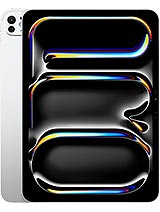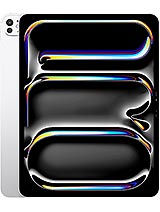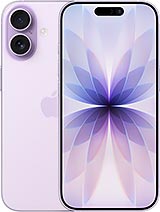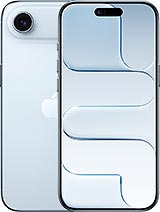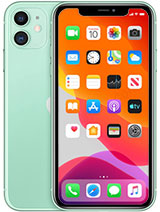
Apple iPhone 11
Announcement / Launch status: September 20,2019
Launch Price: $266
- iOS 13 upgradable to iOS 17.4
- Apple A13 Bionic (7 nm+)
- 6.1 Inches
- 12 MP Front Camera
- 12 MP Back Camera
- 3110 mAh
- 4 GB RAM
- 256 GB Internal Storage
- Variants: A2221, A2111, A2223, iPhone12,1
- Colors: Black, Green, Yellow, Purple, Red, White
Summary
The Apple iPhone 11 is powered by the Apple A13 Bionic (7 nm+) chipset and ships with iOS 13. It is equipped with a RAM of 4GB, 256GB internal storage, 2 rear camera(s), 12 MP + 12 MP Dual-LED dual-tone flash, HDR (photo/panorama) main camera, 12 MP HDR selfie camera, Liquid Retina IPS LCD Scratch-resistant glass display type, 6.1" display size, NFC support, and 3110 mAh battery.
| Brand: | APPLE |
| Model: | iPhone 11 |
| Announcement / Launch Date: | September 20,2019 |
| 2G Support | Yes |
| 3G Support | Yes |
| 4G Support | Yes |
| 5G Support | |
| Dimensions (mm) | 150.9 x 75.7 x 8.3 |
| Weight (g) | 194 |
| SIM | eSIM |
| Display Type | Liquid Retina IPS LCD |
| Display Size (") | 6.1 |
| Display Resolution | Scratch-resistant glass |
| Display ratio | 19.5:9 |
| Display Protection | |
| Operating System (OS) | iOS |
| OS Version (and custom UI) | 13 upgradable to iOS 17.4 |
| Chipset | Apple A13 Bionic (7 nm+) |
| CPU | Hexa-core (2x2.65 GHz Lightning + 4x1.8 GHz Thunder) |
| GPU | Apple GPU (4-core graphics) |
| CPU | Hexa-core (2x2.65 GHz Lightning + 4x1.8 GHz Thunder) |
| External Storage | |
| RAM (GB) | 4 |
| Internal Storage (GB) | 256 |
| RAM + Internal Variants | 64GB 4GB RAM, 128GB 4GB RAM |
| Number Of Selfie Cameras | 1 |
| Selfie Camera (MP) | 12 |
| Selfie Camera Features | 12 MP HDR |
| Selfie Camera Video | 4K@24/30/60fps, 1080p@30/60/120fps, gyro-EIS |
| Number Of Rear Cameras | 2 |
| Rear Camera (MP) | 12 |
| Rear Camera Features | 12 MP + 12 MP Dual-LED dual-tone flash, HDR (photo/panorama) |
| Rear Camera Video | 4K@24/30/60fps, 1080p@30/60/120/240fps, HDR, stereo sound rec. |
| WiFi | Wi-Fi 802.11 a/b/g/n/ac/6, dual-band, hotspot |
| Bluetooth | 5.0, A2DP, LE |
| GPS | GPS, GLONASS, GALILEO, QZSS |
| NFC Support | Wi-Fi 802.11 a/b/g/n/ac/6, dual-band, hotspot |
| Radio | |
| Sensors | Face ID, accelerometer, gyro, proximity, compass, barometer |
| Battery (mAh) | 3110 |
| Colors | Black, Green, Yellow, Purple, Red, White |
| Variants | A2221, A2111, A2223, iPhone12,1 |
| Price (USD) | 266 |
| Additional Information | Glass front (Corning-made glass), glass back (Corning-made glass), aluminum frame (7000 series) IP68 dust/water resistant (up to 2m for 30 min) Apple Pay (Visa, MasterCard, AMEX certified) Ultra Wideband (UWB) support |
2G Network
2G is short for a second-generation cellular network. It is synonymous with CDMA and GSM and is primarily for phone calls, especially in areas without 3G (its successor) coverage. You might also hear of 2.5G (second and a half generation) and 2.75G (EDGE).
3G Network
3G is a third-generation wireless network. 3G is commonly used to access the internet (e.g browser, voice calls, and video calls). It had radio interfaces such as UMTS, W-CDMA, TD-SCDMA, HSPA, HSPA+, and CDMA2000.
4G Network
4G (fourth-generation cellular network) is the successor of 3G and offers faster internet speeds and Voice Over LTE (VOLTE). It has standards like WiMAX and LTE.
5G Network
5G is the fifth-generation cellular network and the successor to 4G. 5G offers lower latency compared to 4G, thereby delivering faster internet speeds and higher bandwidth.
Dimension
This represents the height, width, and depth of the device. Larger dimensions indicate a bulkier device whereas smaller dimensions indicate a more petite frame. Large dimensions sometimes mean larger screen sizes or a sturdy build.
Weight
Weight is how heavy the device is. A light device is better for mobility while a heavy device might be more rugged.
SIM
A Subscriber Identification Module (SIM) card is required to make and receive phone calls without an internet connection. Devices could have no SIM, single SIMs, multiple SIMs, or embedded SIMs (eSIM)
Display Type
The display contributes to how crisp the device renders. Some common display types are LCD, OLED, AMOLED, Super AMOLED, TFT, and IPS.
Display Size
This is how large the screen is. A bigger screen can display more content so it's better for watching videos. Bands and Smartwatches on the other hand have smaller screens for better mobility.
Display Resolution
This is the width by height in pixels which can be used to calculate the total number of dots or pixels on the display. A larger resolution would give a sharper render (at a constant screen size).
Display Ratio
This is the aspect ratio; the ratio of the screen width to height while in landscape.
Display Protection
A tougher screen makes the device's screen less prone to scratches and cracks after some impact. Corning® Gorilla® Glass is one such technology.
Operating System (OS)
The OS is software that manages the memory, processes, hardware, and applications running on the device.
Operating System (OS) Version
This is the version of the operating system with which the device ships. It's usually upgradable to a higher version. A higher OS version offers more features and better security.
Chipset
The Chipset is a single or group of integrated circuits on the motherboard that controls the flow of data between the CPU, memory, and external devices. Some popular chip manufacturers are Mediatek, Qualcomm, Intel, Unisoc / Spreadtrum, HiSilicon, etc
CPU
The Central Processing Unit (CPU) is a circuit that executes basic arithmetic, logic, controlling, and input/output (I/O) operations received as instructions from applications. A powerful CPU translates to great performance in executing tasks i.e works faster.
GPU
The Graphics Processing Unit (GPU) is a circuit that alters computer graphics and image processing to speed up image rendering to the display.
SD Card Support
An external SD card acts as additional storage for media files. It could also be used to extend the internal storage to store more app data.
RAM
The shopping-basket Access Memory (RAM) acts as a temporary storage for the CPU while working on a task. A larger and faster RAM translates to higher processing speeds.
Internal Storage
This serves as a non-volatile storage for your operating system files, app data, and personal data. The larger the internal storage, the more files and applications it can hold.
Camera
This is a measure of the camera's resolution. A larger resolution enables you to take pictures or videos with more detail so they can be cropped yet retain a lot of pixels. Picture quality is more affected by the lens(es), sensor, and software than by the camera's resolution
WiFI
This enables you to either connect to the internet wirelessly or share your mobile internet with other devices. WiFi can also be used for data transfer between devices via wireless networking.
Bluetooth
This is a short-range wireless technology for exchanging data between devices. It'll come in handy for data transfer (small sizes) and pairing with accessories like speakers, headphones, smartwatches, smart bands, etc.
GPS
The Global Positioning System is satellite-based radio navigation that enables you to triangulate the location of a device. It comes in handy when using maps and fitness trackers
NFC
Near Field Communication (NFC) enables data transfer between two devices over a very short distance (about 10 cm). It's widely used in FinTech for payment due to its security features.
Battery
The battery keeps the device running. A larger battery size means more uptime although battery optimization efficiency is determined by the applications and Operating System running on the device.


